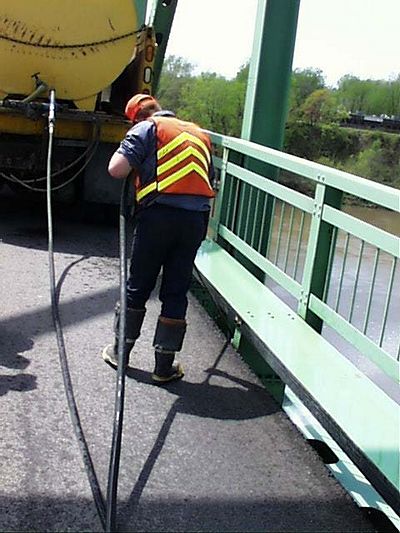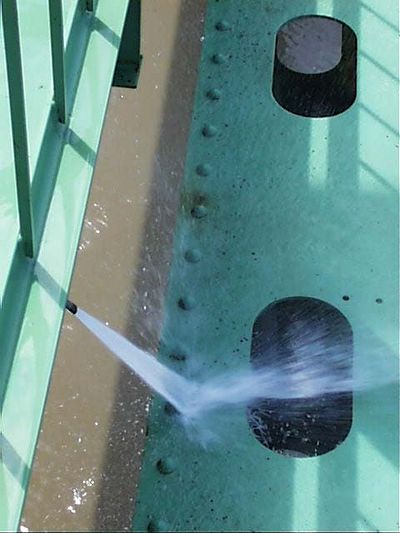771.2 Bridge Cleaning and Flushing
| Code: R329 |
Bridge cleaning and flushing is done to remove dirt and debris to allow proper drainage and drying of the deck. The dirt and debris holds moisture and chlorides that cause deterioration. Deck flushing should be done throughout the winter months when needed and temperatures safely permit. Thorough cleaning of entire bridge should be accomplished in the spring following snow season and again in the fall prior to snow season. This cleaning should include deck, piers, abutments, and lower chords of truss bridges.
Procedures
1. Set up proper traffic control.
2. Removal of dirt and debris shall be completed using dry methods (scraping, vacuuming, or sweeping) to prevent debris, sediments, and other substances from entering waters of the state. Dispose of dirt and debris properly. See EPG 127.25.1.4 Street Sweepings.
3. Adequate water supply and pressure is needed for effective flushing.
4. Spring and fall flushing should include all bridge items, drain system, drain basins, and under expansion devices.
Safety
Run off from flushing needs to be controlled to prevent property and environmental damage.
Guidance on Aquatic Invasive Species Control BMPs
Aquatic invasives such as zebra mussels and some algae species have infested several bodies of water in the United States and can be transported by vessels (barges, boats, tugs, tankers, etc.) and equipment that have been used in areas that contain these invasive species. If equipment is not properly inspected and treated to prevent the spread of invasives, these species can be introduced into areas not currently known to have a population. These invasive species are detrimental to existing ecosystems and can outcompete native species. To assist in preventing the introduction and spread of aquatic invasive species through MoDOT projects in Missouri streams and lakes, the following precautions shall be followed.
Contractors and MoDOT maintenance shall not take water for bridge deck flushing from Waters of the State (i.e., streams or lakes), unless they have implemented appropriate methods to prevent the possible spread of invasive aquatic species. Water sources from municipal water treatment plants or wells may be used without following these measures provided the water hauling equipment has not previously contained waters from streams or lakes. If the water hauling equipment has previously contained waters from other streams or lakes, the following measures must be implemented prior to use.
Prior to transporting temporary barges, tugs, boats, or other equipment used for work in Missouri streams or lakes, or re-using water hauling equipment following any use with water from Missouri streams or lakes, all equipment shall be washed and rinsed thoroughly with hard spray (power wash) or HOT (104° F) water, e.g. at a truck wash facility.
When possible, equipment shall be dried thoroughly, 5-7 days, in the hot sun before using in or transporting between Missouri streams and lakes.
If complete drying is not possible, one of the following treatment methods shall be utilized:
- Treat all interior and exterior surfaces with 140° F water for a minimum of 10 seconds contact on all surfaces.
- Submerge all surfaces in 100% vinegar for 20 minutes.
- Submerge in a solution of 200 ppm chlorine for 10 minutes.
- Treat all bilge water, and reservoirs holding water with a 10% bleach solution to kill any aquatic nuisance species.
All vinegar and chlorine runoff shall be contained and disposed of properly. See EPG 172.5 Wash Water for proper disposal procedures.
To avoid spreading invasive algae, check all gear and remove any visible algae, mud, and plants. Do not dispose of algae into bodies of water. Clean all gear and equipment with a solution of 2% bleach, 5% saltwater, or dish detergent. Allow all equipment to stay in contact with the solution for at least three minutes. Soak all soft items for at least 20 minutes. Dry all gear in the sun for at least 48 hours.
Prior to use of the aforementioned types of vessels, contractors shall provide the MoDOT inspector written documentation of its geographic origin (including the water body it was last used in), as well as defining the specified treatment method used to adequately ensure protection against invasive species.
Vessels and equipment shall be inspected upon removal from any body of water, cleaning hulls, anchors, moorings, trailers, etc., of all mud, vegetation, and any noticeable attached zebra mussels. This practice will assist in preventing the spread of invasive aquatic species between bodies of water. If zebra mussels are found upon inspection, immediate notification must be made to the MoDOT inspector (for contract jobs) and MoDOT Environmental (573-526-4778). A MoDOT Environmental Specialist will contact the Missouri Department of Conservation Aquatic Habitat Specialist (417-326-5189, ext. 1844).




